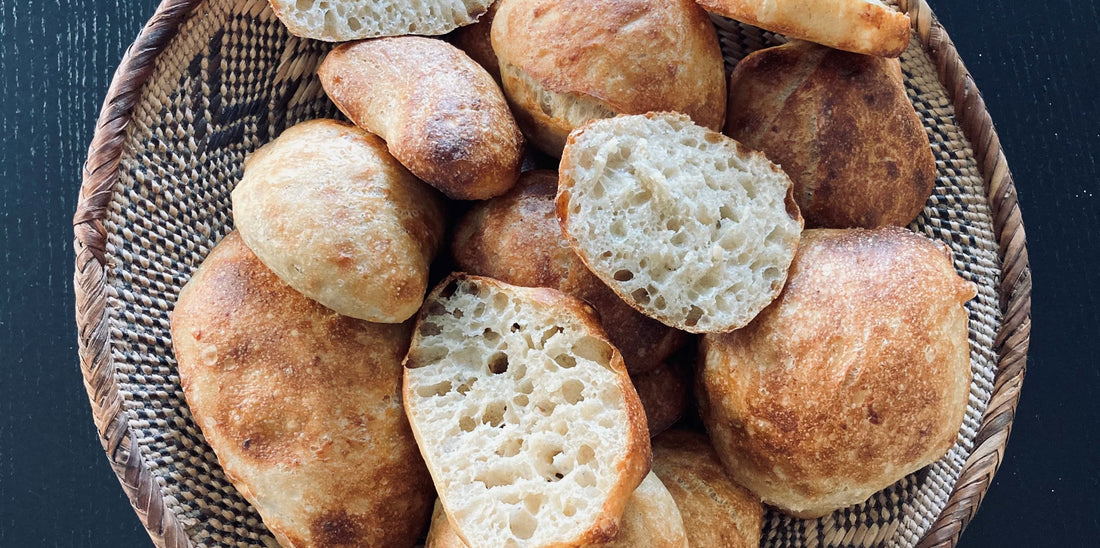
Easy buns with spelled, oatmeal and honey
Share
|
Ingredients :
Wholemeal spelled, strong white flour, sourdough or yeast, water, salt, oatmeal, honey, butter Tool: A bowl and a tea towel to put over while the dough rises |
Time consumption: Dough is mixed, folded, kneaded and baked: 8 hours |

Sourdough bread usually requires a minimum of planning, and I often find that friends and acquaintances are a bit puzzled when they ask about my methods. I usually start by saying something like "So it IS not as circumstantial as it sounds!" But I think that many people assume that there are relatively many stages in the baking of sourdough. Because what does it mean to "freshen up", and how long does it take before you can knead and then bake?
I myself am both quite easy-going and impatient, and I confess with an open mind: I have never started a sourdough from scratch. On the other hand, I have bought one a couple of times and got one from my friend several times. I have no feelings involved in it; it makes my bread rise - PERIOD. That's not to say that I don't think it's festive and quite magical to see it bubble up and get ready to go with flour, salt and water and turn into wonderful bread.
Well, the purpose of this blog post was basically to say: if you want bread in a reasonably short time, it can easily be done, even if you haven't just freshened up the grumpy lady who's standing around bored in the fridge. And if you don't have one, you can also use a bit of yeast and still get delicious, juicy and crispy pieces without a boring yeast taste, if only you use a little enough. If you start the dough in the morning, you have delicious, warm buns for afternoon coffee. And if you start them late in the evening, they are ready to bake for breakfast.
Bon appetit!
Tool:
A bowl and a tea towel to put over while the dough rises
Ingredients:
- 100 g wholemeal spelled
- 400 g strong, white flour, e.g. Type xx
- 2-3 tablespoons fresh sourdough straight from the fridge, alternatively a few grams of yeast (use the organic one, it is made from more yeast strains than the conventional one and gives a slightly better taste and structure)
- 350 g very warm water
- 12 g of salt
- Porridge of 1 dl oatmeal and 2 dl water
- 1 large tablespoon of honey
- 1 large tablespoon of butter
Course of action:
- Flour, water and sourdough starter are stirred together until all the flour is wet. Set the dough aside and let it rest for half an hour to a full hour.
- Meanwhile, the porridge is boiled, which is then added to butter, honey and salt. Pour if necessary transfer the porridge to a deep plate to cool.
- Squeeze the porridge well into the dough - it will make a worse mess, but it will probably collect later.
- After approx. Half an hour the dough must have a first "turn" - see Michael's video below, where he shows the procedure. During the next few hours, it will have the same treatment 3-4 times: the dough, which is rather wet and limp, will gradually become smooth and come together. You can also just knead it through, but because of the spelled flour you have to be quite gentle, and I always get a much better result by turning the dough over a few hours.
- Let the dough rise on the kitchen counter for 4-5 hours from the last turn; it should rise to almost twice its size. Another sign that it is ready is that it blisters and sloshes and feels like a slightly wet chocolate mousse when you lift up its sides.
- Heat the oven with a baking tray to 250 degrees without fan. If you are the lucky owner of a good baking stone or a baking steel, you will probably get an even better result than mine - but an ordinary baking sheet can easily work.
- To make the finished buns, you can either scrape the whole dough out onto the table and chop it into pieces, or you can dip your hands in water and pinch pieces of the dough directly from the bowl and put them on the plate - I myself use the latter method ( you can also do the same with a few spoons dipped in water). Do not start shaping the buns or they will lose their puffiness and become flat.
- Put the plate in the middle of the oven, throw a small cup of water into the bottom to create steam, and turn down to 220 degrees. Let the buns bake until they are dark golden, it takes approx. 20 minutes, but watch out: each oven has its own charm and soul. Due to the porridge, it is important that they are well baked, otherwise it will be a difficult time.
- Repeat with another plate full.
- Allow the buns to cool slightly and ENJOY.
The dough is folded and stretched (Extracts from Rugkop's online baking course )
Anyone can learn to bake light sourdough bread. Buy our online course and have flour and equipment delivered to the door.
